Sir John Monash, Personal Files Book 16, 1 August - 3 September 1917, Part 7
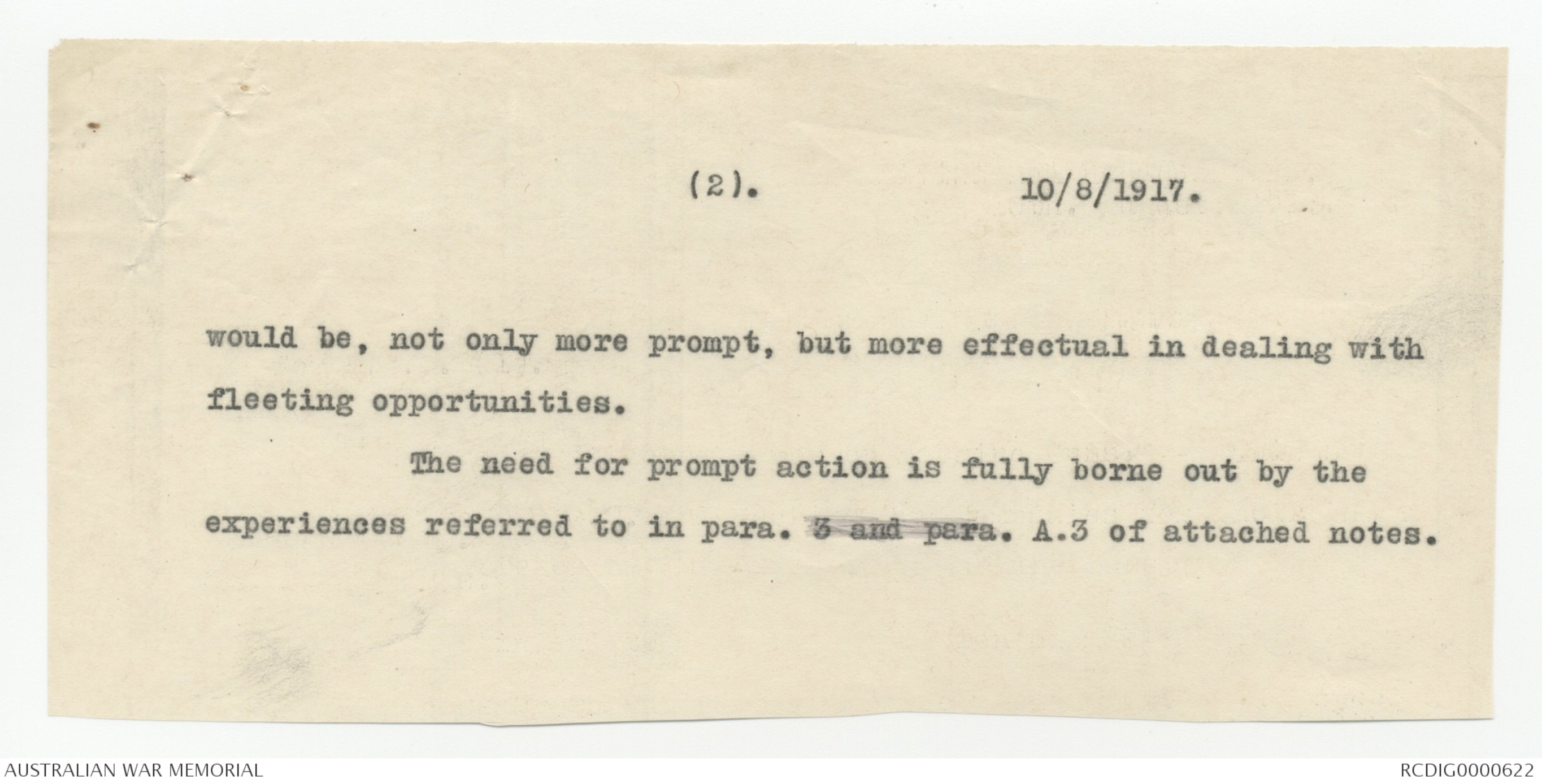
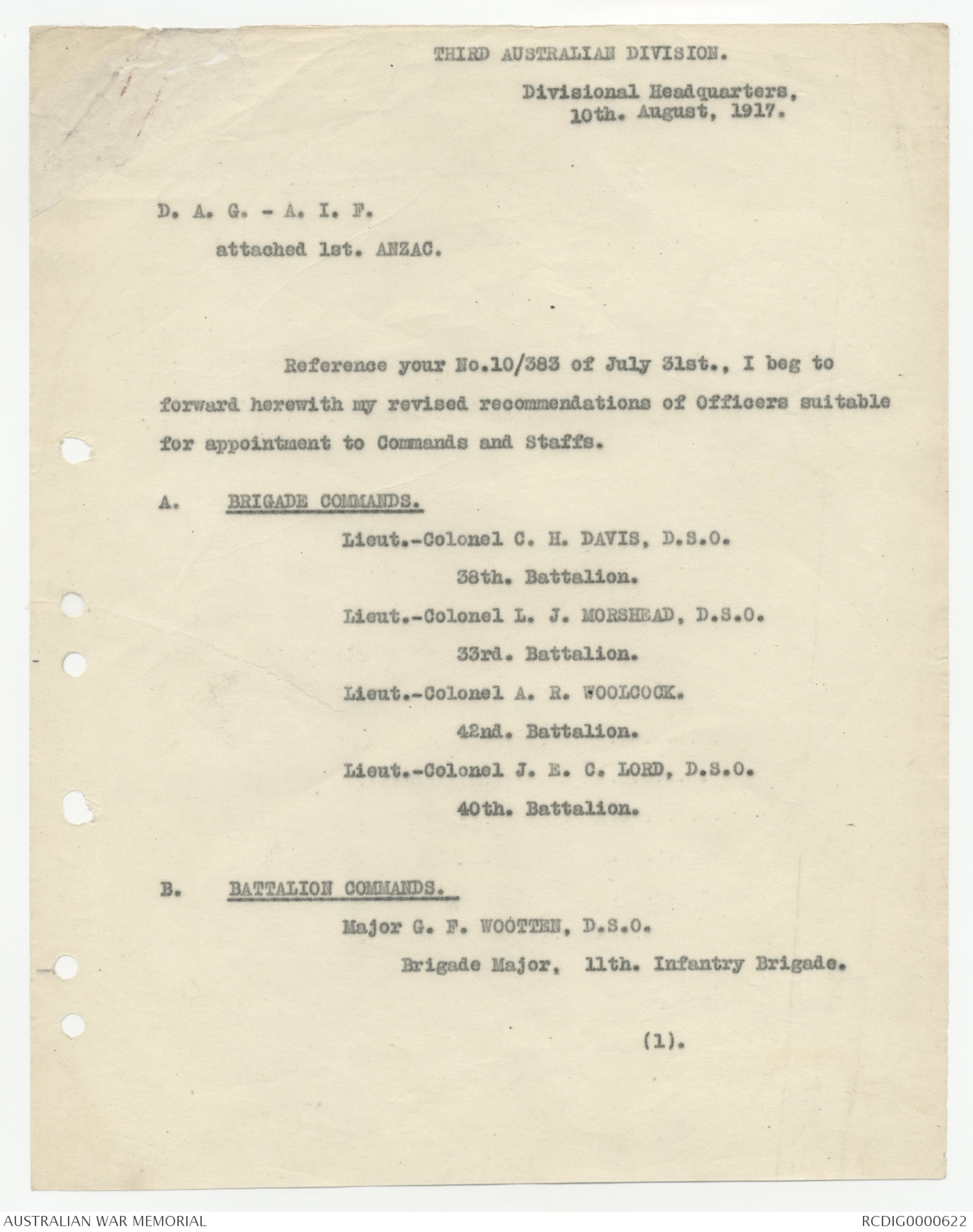
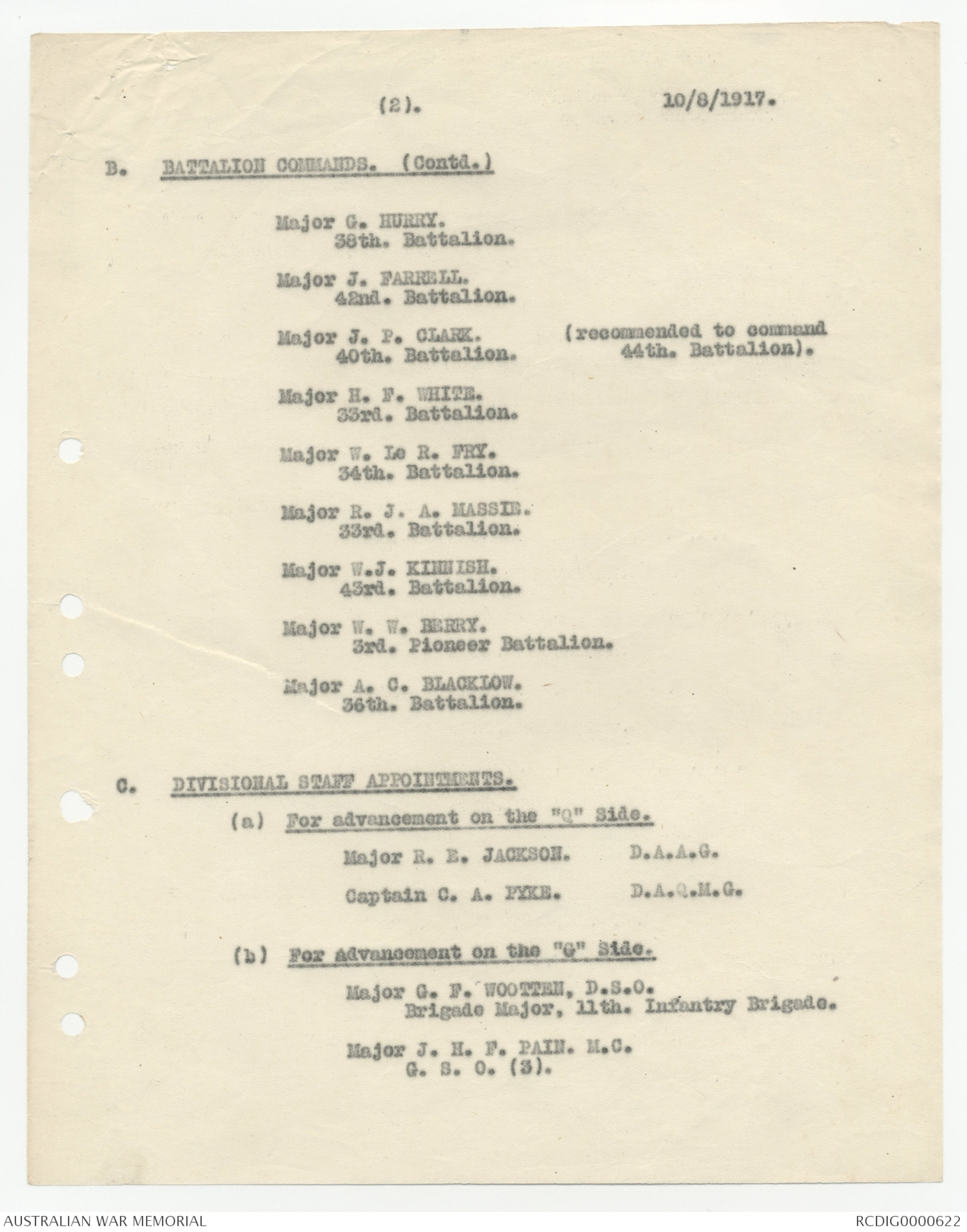
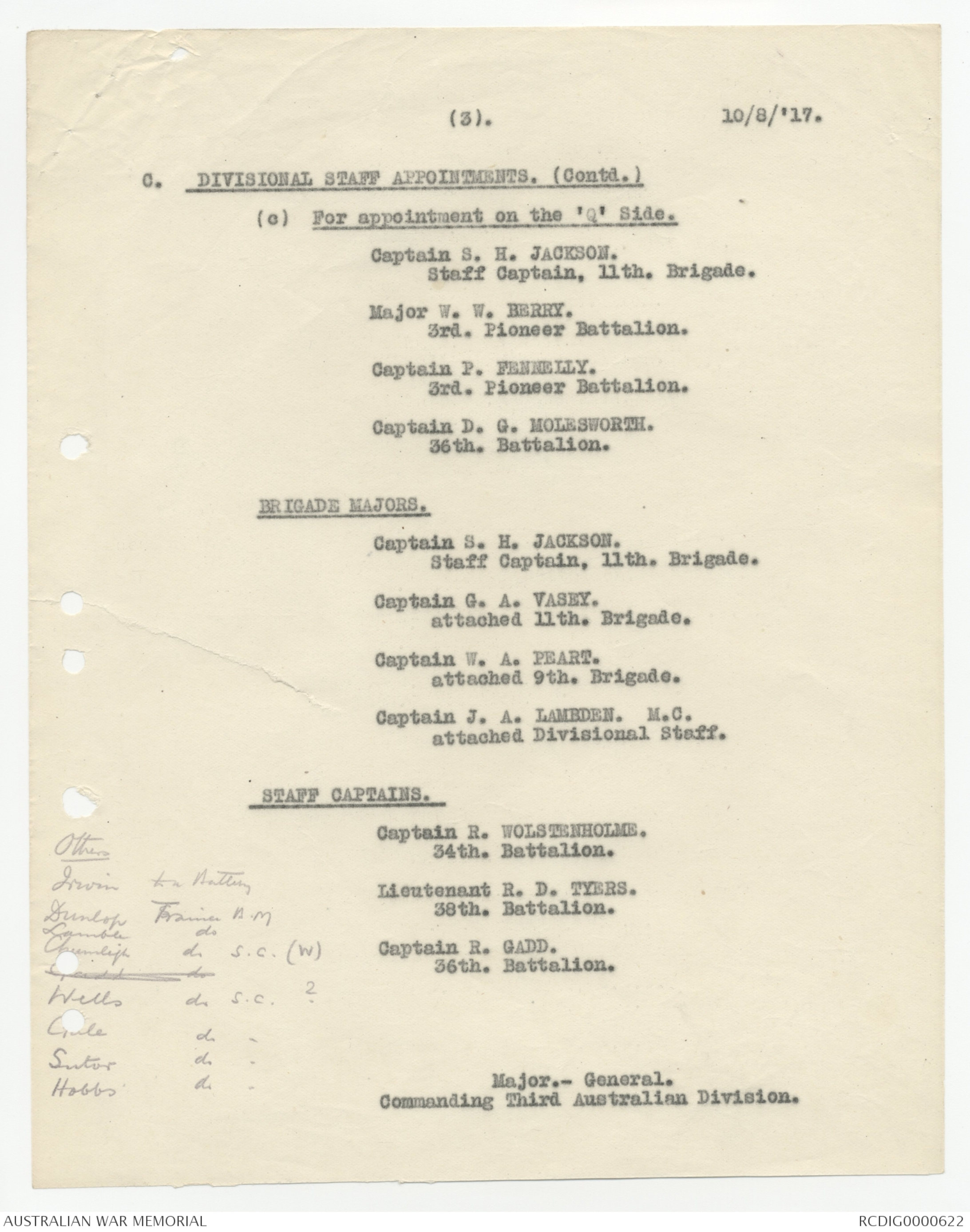
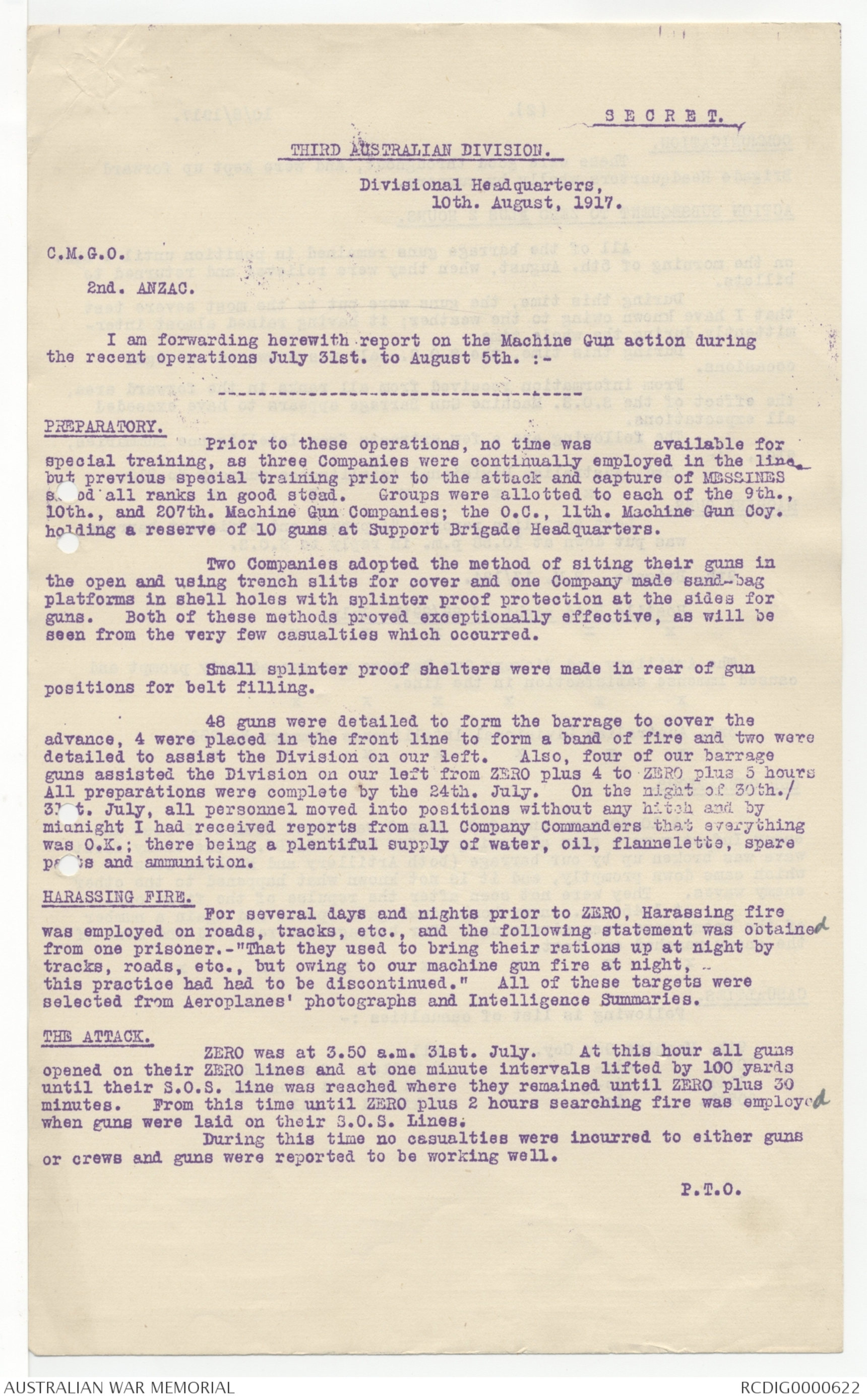
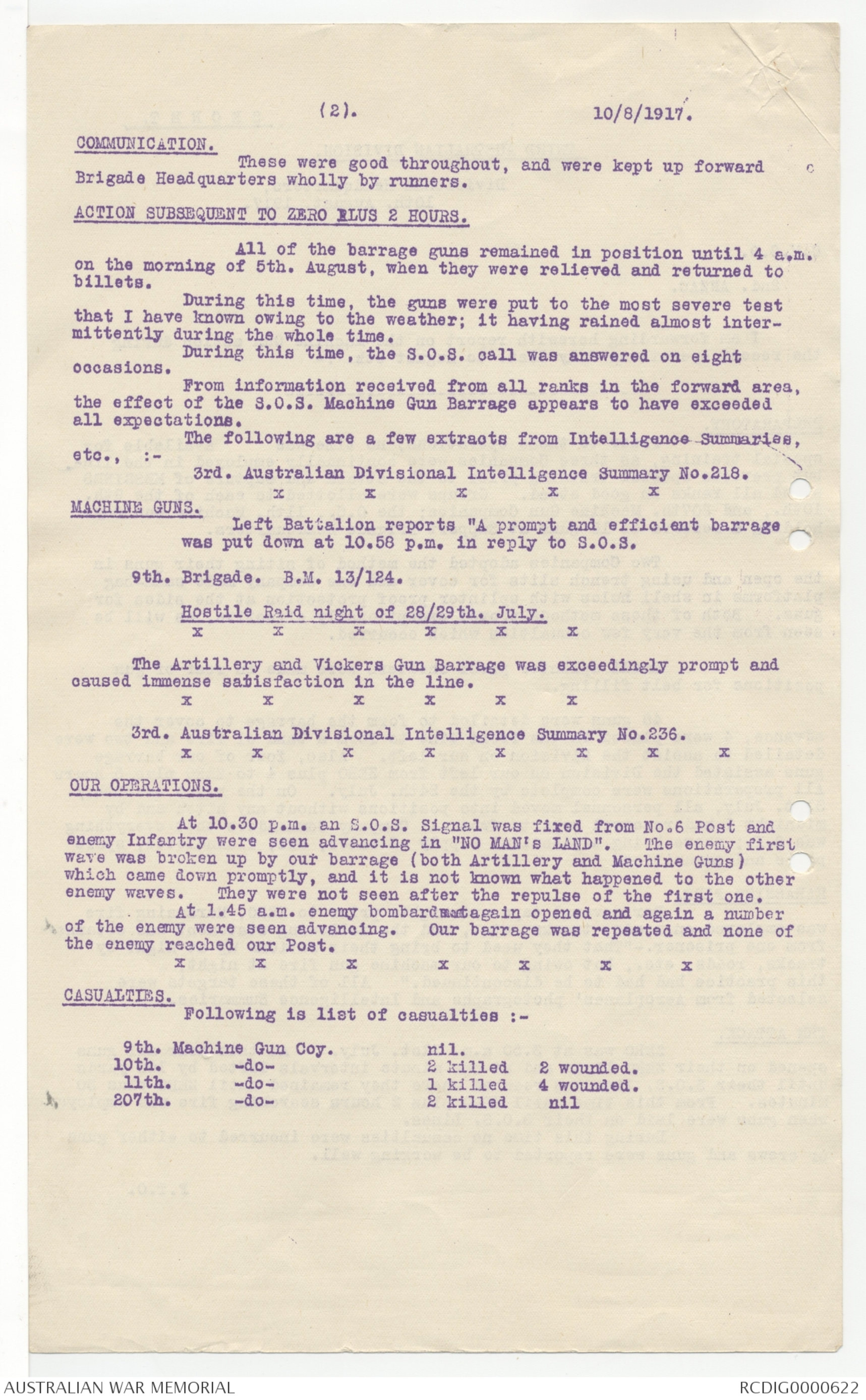
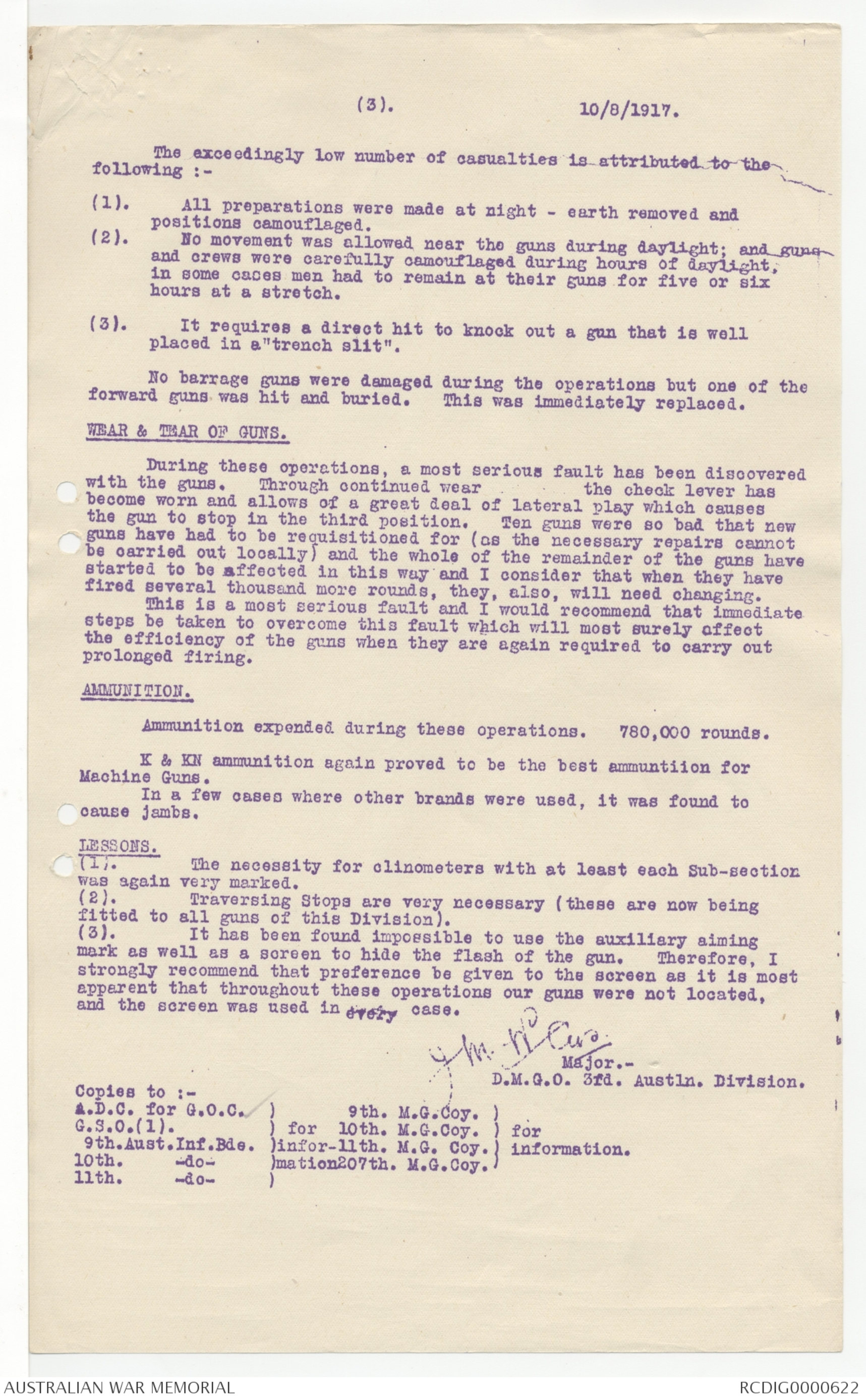
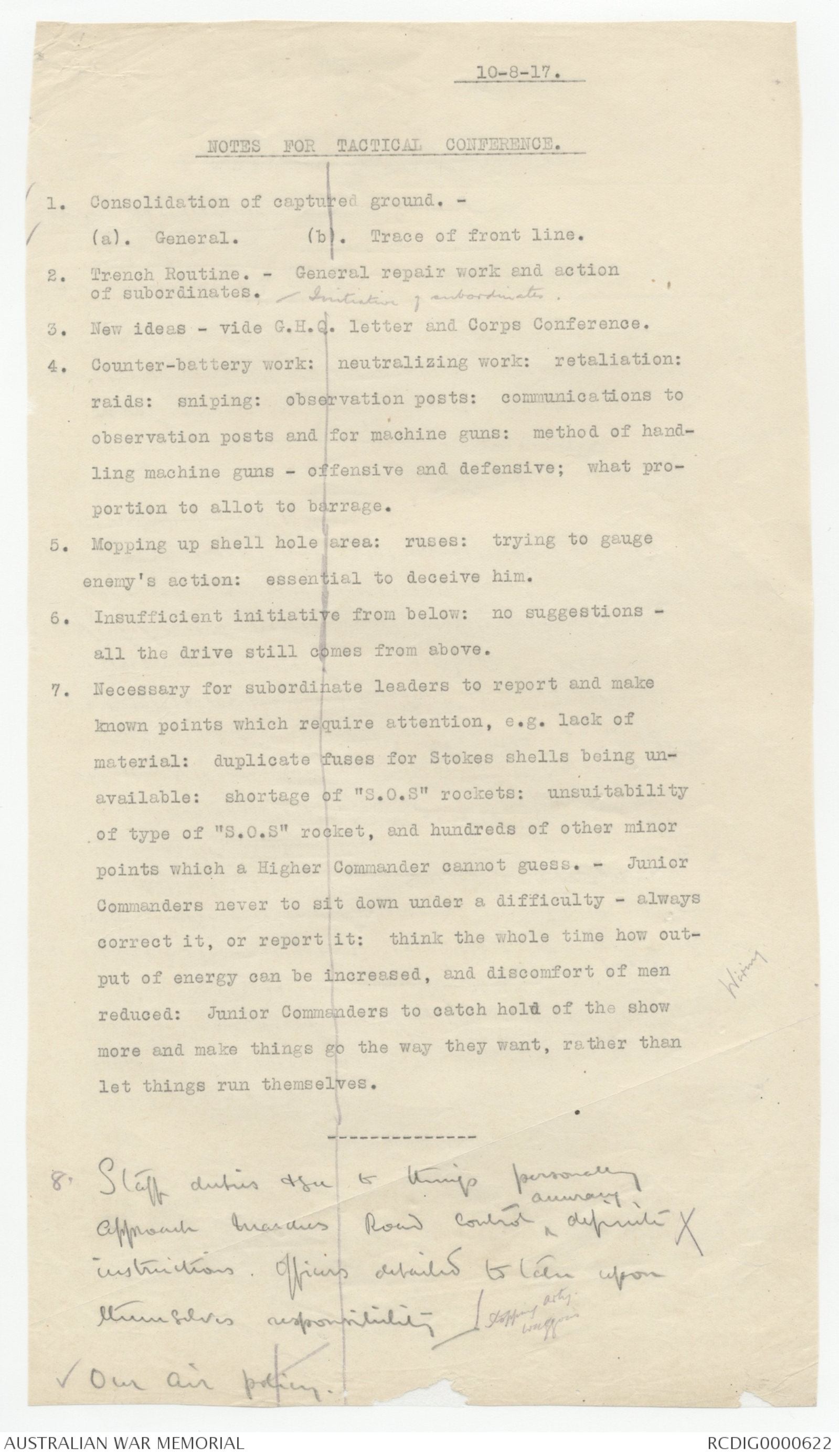
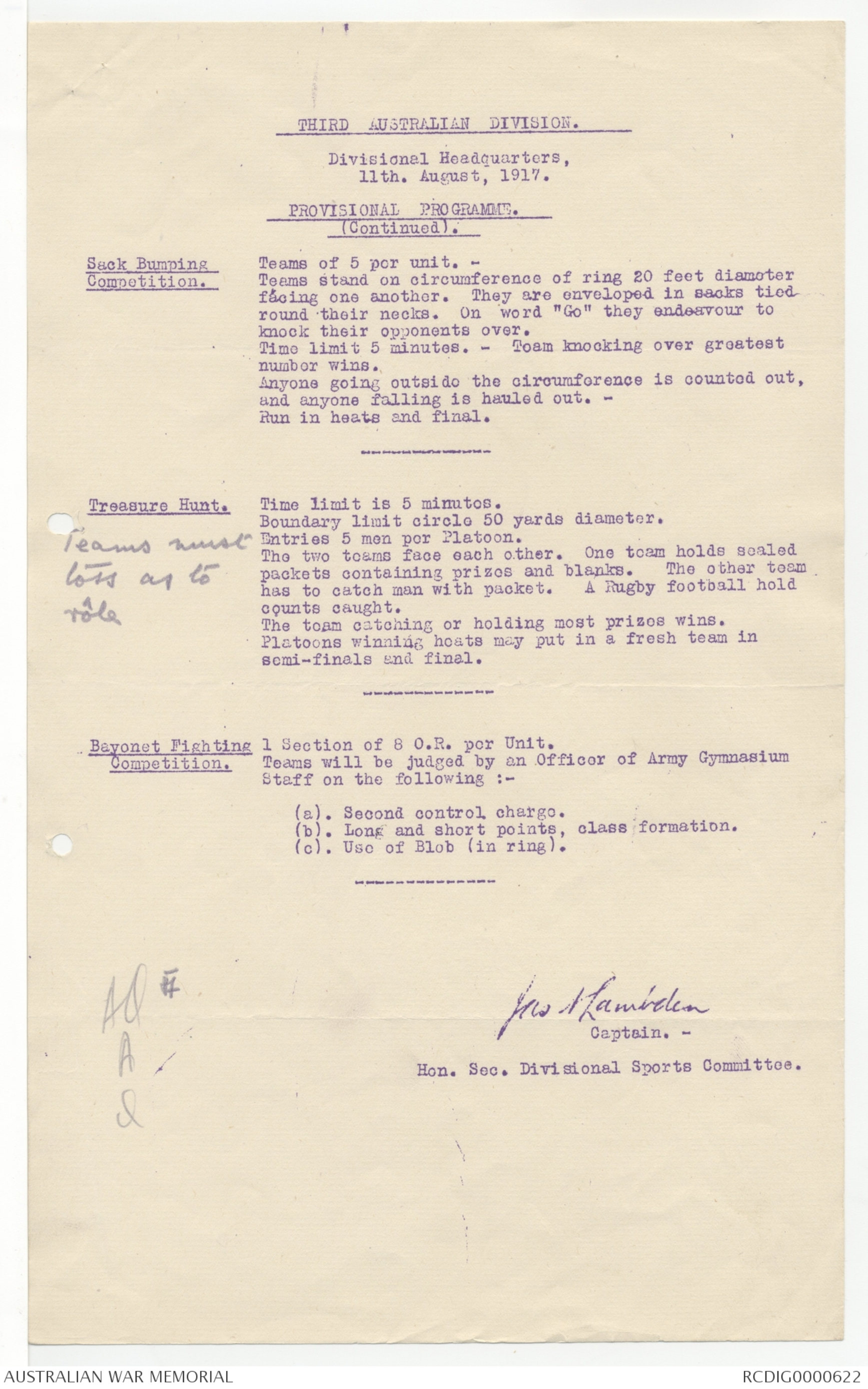
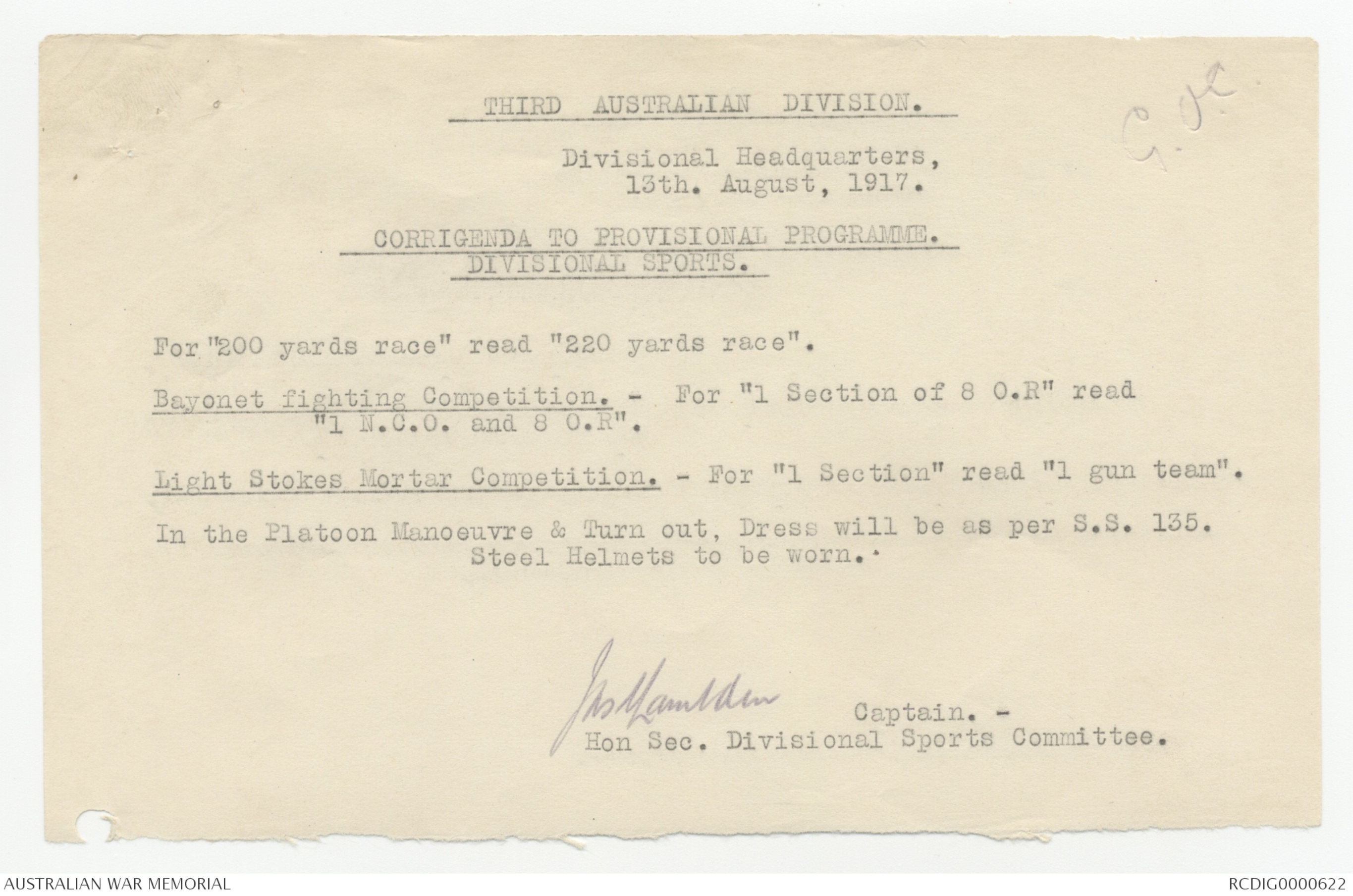
(2). 10/8/1917.
would be, not only more prompt, but more effectual in dealing with
fleeting opportunities.
The need for prompt action is fully borne out by the
experiences referred to in para. 3 and para. A.3 of attached notes.
THIRD AUSTRALIAN DIVISION.
Divisional Headquarters,
10th. August, 1917.
D.A.G. - A.I.F.
attached 1st. ANZAC.
.
Reference your No. 10/383 of July 31st., I beg to
forward herewith my revised recommendations of Officers suitable
for appointment to Commands and Staffs.
A. BRIGADE COMMANDS.
Lieut.-Colonel C. H. DAVIS. D.S.O.
38th. Battalion.
Lieut.-Colonel L. J. MORSHEAD, D.S.O.
33rd. Battalion.
Lieut.-Colonel A. R. WOOLCOCK.
42nd. Battalion.
Lieut.-Colonel J. E. C. LORD, D.S.O.
40th. Battalion.
B. BATTALION COMMANDS.
Major G. F. WOOTTEN, D.S.O.
Brigade Major, 11th. Infantry Brigade.
(1).
(2). 10/8/1917.
B. BATTALION COMMANDS. (Contd.)
Major G. HURRY.
38th. Battalion.
Major J. FARRELL.
42nd. Battalion.
Major J. P. CLARK. (recommended to command
40th. Battalion. 44th. Battalion).
Major H. F. WHITE.
33rd. Battalion.
Major W. Le R. FRY.
34th. Battalion.
Major R. J. A. MASSIE.
33rd. Battalion.
Major W.J. KINNISH.
43rd. Battalion.
Major W. W. BERRY.
3rd. Pioneer Battalion.
Major A. C. BLACKLOW.
36th. Battalion.
C. DIVISIONAL STAFF APPOINTMENTS.
(a) For advancement on the "Q" Side.
Major R. E. JACKSON. D.A.A.G.
Captain C. A. PYKE. D.A.Q.M.G.
(b) For Advancement on the "G" Side.
Major G. F. WOOTTEN, D.S.O.
Brigade Major, 11th. Infantry Brigade.
Major J. H. F. PAIN. M.C.
G. S. O. (3).
(3). 10/8/'17.
C. DIVISIONAL STAFF APPOINTMENTS. (Contd.)
(c) For appointment on the 'Q' Side.
Captain S. H. JACKSON.
Staff Captain, 11th. Brigade.
Major W. W. BERRY.
3rd. Pioneer Battalion.
Captain P. FENNELLY.
3rd. Pioneer Battalion.
Captain D. G. MOLESWORTH.
36th. Battalion.
BRIGADE MAJORS.
Captain S. H. JACKSON.
Staff Captain, 11th. Brigade.
Captain G. A. VASEY.
attached 11th. Brigade.
Captain W. A. PEART.
attached 9th. Brigade.
Captain J. A. LAMBDEN. M.C.
attached Divisional Staff.
STAFF CAPTAINS.
Captain R. WOLSTENHOLME.
34th. Battalion.
Lieutenant R. D. TYERS.
38th. Battalion.
Captain R. GADD.
36th. Battalion.
Major.- General.
Commanding Third
Australian Division.
[*Others
Irwin to a Battery
Dunlop Trainer B.M
Lamble do
Chumligh do S.C. (W)
[[Speidd?]] do
Wells do S.C. ?
[[Gule]] do -
Sutor do -
Hobbs do -*]
SECRET.
THIRD AUSTRALIAN DIVISION.
Divisional Headquarters,
10th. August, 1917.
C.M.G.O.
2nd. ANZAC.
I am forwarding herewith report on the Machine Gun action during
the recent operations July 31st. to August 5th. :-
PREPARATORY.
Prior to these operations, no time was available for
special training, as three Companies were continually employed in the line.
but previous special training prior to the attack and capture of MESSINES
stood all ranks in good stead. Groups were allotted to each of the 9th.,
10th., and 207th. Machine Gun Companies; the O.C., 11th. Machine Gun Coy.
holding a reserve of 10 guns at Support Brigade Headquarters.
Two Companies adopted the method of siting their guns in
the open and using trench slits for cover and one Company made sand-bag
platforms in shell holes with splinter proof protection at the sides for
guns. Both of these methods proved exceptionally effective, as will be
seen from the very few casualties which occurred.
Small splinter proof shelters were made in rear of gun
positions for belt filling.
48 guns were detailed to form the barrage to cover the
advance, 4 were placed in the front line to form a band of fire and two were
detailed to assist the Division on our left. Also, four of our barrage
guns assisted the Division on our left from ZERO plus 4 to ZERO plus 5 hours
All preparations were complete by the 24th. July. On the night of 30th./
31st. July, all personnel moved into positions without any hitch and by
midnight I had received reports from all Company Commanders that everything
was O.K.; there being a plentiful supply of water, oil, flannelette, spare
parts and ammunition.
HARASSING FIRE.
For several days and nights prior to ZERO, Harassing fire
was employed on roads, tracks, etc., and the following statement was obtained
from one prisoner.-"That they used to bring their rations up at night by
tracks, roads, etc., but owing to our machine gun fire at night,
this practice had had to be discontinued." All of these targets were
selected from Aeroplanes' photographs and Intelligence Summaries.
THIS ATTACK.
ZERO was at 3.50 a.m. 31st. July. At this hour all guns
opened on their ZERO lines and at one minute intervals lifted by 100 yards
until their S.O.S. line was reached where they remained until ZERO plus 30
minutes. From this time until ZERO plus 2 hours searching fire was employed
when guns were laid on their S.O.S. Lines.
During this time no casualties were incurred to either guns
or crews and guns were reported to be working well.
P.T.O.
(2). 10/8/1917.
COMMUNICATION.
These were good throughout, and were kept up forward
Brigade Headquarters wholly by runners.
ACTION SUBSEQUENT TO ZERO PLUS 2 HOURS.
All of the barrage guns remained in position until 4 a.m.
on the morning of 5th. August, when they were relieved and returned to
billets.
During this time, the guns were put to the most severe test
that I have known owing to the weather; it having rained almost intermittently
during the whole time.
During this time, the S.O.S. call was answered on eight
occasions.
From information received from all ranks in the forward area,
the effect of the S.O.S. Machine Gun Barrage appears to have exceeded
all expectations.
The following are a few extracts from Intelligence Summaries,
etc., :-
3rd. Australian Divisional Intelligence Summary No.218.
MACHINE GUNS.
Left Battalion reports "A prompt and efficient barrage
was put down at 10.58 p.m. in reply to S.O.S.
9th. Brigade. B.M. 13/124.
Hostile Raid night of 28/29th. July.
The Artillery and Vickers Gun Barrage was exceedingly prompt and
caused immense satisfaction in the line.
3rd. Australian Divisional Intelligence Summary No.236.
OUR OPERATIONS.
At 10.30 p.m. an S.O.S. Signal was fired from No.6 Post and
enemy Infantry were seen advancing in "NO MAN's LAND". The enemy first
wave was broken up by our barrage (both Artillery and Machine Guns)
which came down promptly, and it is not known what happened to the other
enemy waves. They were not seen after the repulse of the first one.
At 1.45 a.m. enemy bombardment again opened and again a number
of the enemy were seen advancing. Our barrage was repeated and none of
the enemy reached our Post.
CASUALTIES.
Following is list of casualties :-
9th. Machine Gun Coy. nil.
10th. -do- 2 killed 2 wounded
11th. -do- 1 killed 4 wounded.
207th. -do- 2 killed nil
(3). 10/8/1917.
The exceedingly low number of casualties is attributed to the
following:-
(1). All preparations were made at night - earth removed and
positions camouflaged.
(2). No movement was allowed near the guns during daylight; and guns
and crews were carefully camouflaged during hours of daylight,
in some cases men had to remain at their guns for five or six
hours at a stretch.
(3). It requires a direct hit to knock out a gun that is well
placed in a "trench slit".
No barrage guns were damaged during the operations but one of the
forward guns was hit and buried. This was immediately replaced.
WEAR & TEAR OF GUNS.
During these operations, a most serious fault has been discovered
with the guns. Through continued wear the check lever has
become worn and allows of a great deal of lateral play which causes
the gun to stop in the third position. Ten guns were so bad that new
guns have had to be requisitioned for (as the necessary repairs cannot
be carried out locally) and the whole of the remainder of the guns have
started to be affected in this way and I consider that when they have
fired several thousand more rounds, they, also, will need changing.
This is a most serious fault and I would recommend that immediate
steps be taken to overcome this fault which will most surely affect
the efficiency of the guns when they are again required to carry out
prolonged firing.
AMMUNITION.
Ammunition expended during these operations. 780,000 rounds.
K & KN ammunition again proved to be the best ammunition for
Machine Guns.
In a few cases where other brands were used, it was found to
cause jambs.
LESSONS.
(1). The necessity for clinometers with at least each Sub-section
was again very marked.
(2). Traversing Stops are very necessary (these are now being
fitted to all guns of this Division).
(3). It has been found impossible to use the auxiliary aiming
mark as well as a screen to hide the flash of the gun. Therefore, I
strongly recommend that preference be given to the screen as it is most
apparent that throughout these operations our guns were not located,
and the screen was used in every case.
(J M McNicol)
Major. -
D.M.G.O. 3rd. Austln. Division.
Copies to :-
A.D.C. for G.O.C 🗸 ) 9th. M.G.Coy. )
G.S.O.(1) ) for 10th. M.G.Coy. ) for
9th. Aust. Inf. Bde. ) information
11th. M.G.Coy.
) information.
10th. -do- ) 207th. M.G.Coy)
11th . -do- )
10-8-17.
NOTES FOR TACTICAL CONFERENCE.
1. Consolidation of captured ground. -
(a). General. (b). Trace of front line.
2. Trench Routine. - General repair work and action
of subordinates. Initiation of subordinates.
3. New ideas - vide G.H.Q. letter and Corps Conference.
4. Counter-battery work: neutralizing work: retaliation:
raids: sniping: observation posts: communications to
observation posts and for machine guns: method of handling
machine guns - offensive and defensive; what proportion
to allot to barrage.
5. Mopping up shell hole area: ruses: trying to gauge
enemy's action: essential to deceive him.
6. Insufficient initiative from below: no suggestions -
all the drive still comes from above.
7. Necessary for subordinate leaders to report and make
known points which require attention, e.g. lack of
material: duplicate fuses for Stokes shells being unavailable:
shortage of "S.O.S" rockets: unsuitability
of type of "S.O.S" rocket, and hundreds of other minor
points which a Higher Commander cannot guess. - Junior
Commanders never to sit down under a difficulty - always
correct it, or report it: think the whole time how output
of energy can be increased, and discomfort of men
reduced: Junior Commanders to catch hold of the show (*wiring)
more and make things go the way they want, rather than
let things run themselves.
8. Staff duties to see to things personally
Approach Marches Road Control ^arranging definite X
instructions. Officers detailed to take upon
themselves responsibility.
Staffing arty
waggons
√ Our air policy
THIRD AUSTRALIAN DIVISION.
Divisional Headquarters,
11th. August, 1917.
PROVISIONAL PROGRAMME.
(Continued).
Sack Bumping Teams of 5 per unit. -
Competition. Teams stand on circumference of ring 20 feet diameter
facing one another. They are enveloped in sacks tied
round their necks. On word "Go" they endeavour to
knock their opponents over.
Time limit 5 minutes. - Team knocking over greatest
number wins.
Anyone going outside the circumference is counted out,
and anyone falling is hauled out.
Run in heats and final.
Treasure Hunt. Time limit is 5 minutes.
Boundary limit circle 50 yards diameter.
Entries 5 men per Platoon.
The two teams face each other. One team holds sealed
packets containing prizes and blanks. The other team
has to catch man with packet. A Rugby football hold
counts caught.
The team catching or holding most prizes wins.
Platoons winning heats may put in a fresh team in
semi-finals and final.
[*Teams must
toss as to
rôle*]
Bayonet Fighting 1 Section of 8 O.R. per Unit.
Competition. Teams will be judged by an Officer of Army Gymnasium
Staff on the following: -
(a). Second control charge.
(b). Long and short points, class formation.
(c). Use of Blob (in ring).
Jas A Lambden
Captain. -
Hon. Sec. Divisional
Sports Committee.
[[*AQ E
A
Q*]]
(*G.O.C.*)
THIRD AUSTRALIAN DIVISION
Divisional Headquarters,
13th. August, 1917.
CORRIGENDA TO PROVISIONAL PROGRAMME.
DIVISIONAL SPORTS.
For "200 yards race" read "220 yards race".
Bayonet fighting Competition. - For "1 Section of 8 O.R "read
"1 N.C.O. and 8 O.R".
Light Stokes Mortar Competition. - For "1 Section" read "1 gun team".
In the Platoon Manoeuvre & Turn out, Dress will be as per S.S. 135.
Steel Helmets to be worn.
Jas A Lambden
Captain. -
Hon Sec. Divisional Sports Committee.
 Sam scott
Sam scottThis transcription item is now locked to you for editing. To release the lock either Save your changes or Cancel.
This lock will be automatically released after 60 minutes of inactivity.